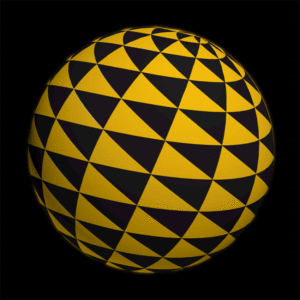What can you write about the "F" sound?
It would seem that not so much, because it could be considered only an "ef".
I understood the very essence of this sound by subtracting this "E" which "strengthen " it "from" ef "and pronouncing it as pure "F". Thus, I suggest that you pronounce the single sound several times while reading it. When you repeat it, you will notice that you blow hard and while deflating, you will push the lower jaw slightly forward. Very similarly "P" is pronounced. By pronouncing "P" without adding "E" at the end you will hear that it is slightly quieter, but you will also feel a strong blow. You can notice that with regard to this sound, unlike the "F", we do not push the lower jaw forward.
"P" and "F" as a flame / torch, which in Latin reads: flamma / fax
In order to describe "F" properly I have to present "P" simultaneously. In Polish, words beginning with "F" are often derived from other languages.
Look at "F" and "P". They look similar.
So what could the people of the Great Culture and ancestors of Etruscans could draw as Pre-Letters to illustrate these sounds? I suppose they drew what could be blown away - a burning log called a torch. The difference between "P" and "F" will be expressed in the dynamics of this torch, as it is contained in the pronunciation of sounds. Because when pronouncing "P", our mouth maintains a less dynamic arrangement than with "F", this torch will be static either. As we can see, the flame burns as if carried calmly, or even held firmly in the right hand.

Considered as a more dynamic one, the pre-letter "F" received more speed, as if moved by a torch.

I suppose the torch, an invention used to illuminate the dark surroundings, was not only used for that. I think it was a prop used to emphasise the sense of the story. To this day there are performances where fire is used as an additional element of expression. I think it is a very long tradition. In addition to sound, each story is based on a play of light with darkness, just like the screen on which you read these words.
In the past, most of the stories were didactic, even fairy tales that children were told until recently were to fulfil educational functions. They were so-called moral tales. At a time when man lived in the narrative of cosmic-animalistic beliefs, the stories had to relate both to himself and the animal world and space. So how could one explain the role of the sun, moon and other planets of the solar system, as well as their impact on the life of a man of Great Culture?
It seems to me that, like today, we do it, i.e. using teaching aids. Today, a large role in illustrating the rules governing the world is played by animations, thanks to which we can more easily understand how planets move around the Earth and how our solar system travels in our galaxy.
We often learn by watching movies and even playing games on computers and mobile devices. Before all these technological miracles were created, simpler methods had to be used. In the Renaissance, as we know, spatial heliocentric models were constructed, constituting the operation of our solar system. Earlier, in the Middle Ages, also called the Dark Ages, people were told that the earth is the centre of our system. This was because the religions of the new civilisation competed with the old beliefs of the Great Culture.
It can be said that paradoxically - because they grew out of it, destroying its cosmic-animalistic beliefs - they re-composed it, using fragments of its beliefs. During this period, logical models of the functioning of the cosmos were dispensable, and, I suppose, doctrine and brute force were enough to impose a new narrative on the defeated people. For this reason, we do not know well the achievements of the Great Culture, but only its traces present in Greek myths, which survived thanks to their poetic form, concealing under the "veil" of allegorical layer, the essential meaning of the story.
These traces can also be found in the major religions of our civilisation. We also know it thanks to the legacy of Egypt and Sumer, whose writings were forgotten and as such - they were not considered a threat, so they were not destroyed. We can get to know her better thanks to distant cultures, where the heritage of those times still survived. It is significant that written witnesses of those times, created by the later conquered Celts and Scythians, were destroyed. This destruction of their written monuments leads to a well-established (in science) opinion that they did not have a writing system. So how were the planet's motions explained during the time of Great Culture?
I think that at the beginning the planets were represented by torches held in the hands of people depicting them. It was enough to name a person by the name of the planet, give him the attribute of a celestial body and order him to imitate the revolution - along a line drawn on earth - around another "celestial body." Some of them were "free", others "imprisoned" by the embrace of dependence called today attraction. They were all moving, because the common feature of heavenly bodies is movement. The movement of the planets and their interaction with each other affects the climate of the earth and so was and is for man not only the object of interest, but also a phenomenon that raises his respect. How this respect was manifested was described by me to a large extent when presenting the Pre-Letter "C".
Imagine this spectacle, seen from above, from a bird's eye perspective. Representation in which many planets move on circular trajectories around other planets. If you played a role in it and if you were the moon, then you would remember how it moves relative to Earth, and the latter in relation to the sun, for the rest of your life.
I think that this kind of "didactic aids" held in hands evolved to such an extent so that you can also reconstruct and play the scenes between planets during the day. If so, then the torch originally used turned into a long staff of the "traveler", crowned with the attribute of a given planet - because "heavenly bodies" travel.
In order to reflect the "brightness" of the planets, the crown of these torches was probably covered with precious metals. The use of gold or silver allowed them to shine reflecting sunlight like planets that "shine" reflecting it. These are the attributes we can see in the hands of the pharaohs on numerous monuments. Until recently, they symbolised royal power, and even Papal power is emphasised by a pastoral, whose form changed over the centuries, but was always symbolically significant.
Thus you can treat "P" and "F" as sounds symbolising power - "placed" on a long shaft. The very nature of these planetary attributes were - were indicated by Greek myths, which I will try to refer to in the text below, in order to characterise the roles "P" and "F" closer. The poetry of these myths will relate to the cosmos and the life on earth dependent on it. Today, this elegant form is replaced by the language of science we are used to. Therefore, I will use both these forms alternately.
Pre - letters "P" and "F" in ancient Greece and Rome.
Writing about "P" and "F" I will remind you of one of the titans - Prometheus, who first created man and then brought him fire, out of mercy over the fate of mankind lost in darkness. Because I go back to the time of those myths, I would like to emphasise that "gods", in my opinion, were originally avatars of the monotheistic God. Thus, the Greek "gods" whose names begin with "P" such as the Pan will be associated with the fertility of the earth, and this, as we know, has to do with the wind because it is the latter that contributes to the spread of spores by spreading plants. Surely, you have often seen the wind-blown seeds of dandelion, chestnut or linden wandering around.
Those who are interested in agriculture know that fields and glades were once obtained by logging and then burning wood. Fertile soil was once sown in the moonlight, at night. If sowing was carried out at night, it probably also by the light of the torches.
To this day, in the minds of many people, burning grass is supposed to contribute to fertilisation of the soil. Until recently, one of the natural fertilisers was considered ash with a lot of potassium, magnesium, sodium and calcium. Ash, as a fertiliser, is best used for plants that like alkaline soil because it contains a lot of calcium. This alkalinity or acidity of the earth is called its pH.
PH = F
Earth also produces crops thanks to light - this process is called photosynthesis. This word comes from the Greek word "photos" or "light", and is pronounced as "fotos". Relationships of sounds "P", "H" and "F" are clearly shown by Greek Mythology - which I will try to describe further. As for the photosynthesis, it should be emphasised that it involves the transformation of inorganic matter into organic matter. It is carried out in two stages.
The first stage, when the light is absorbed, is called the bright phase. In this phase, solar energy is converted into the energy of chemical bonds, and its side effect is the evolution of oxygen.
The second stage is called the dark phase, in which the energy of chemical bonds is used to synthesise organic bonds.
At this point, we should move to Rome, specifically to the Borghese Gallery, where one can admire a phenomenal sculpture created in 1621-1622 by Giovani Bernini, entitled “The Rape of Proserpina”. Proserpine, according to the beliefs of the Romans, was kidnapped by Pluto. I will try to describe below how Greek poetic myths were associated with the cosmic beliefs of the Great Culture.
In ancient Greece, Proserpine was called Persephone, and Pluto was Hades. The scene Bernini portrays represents Persephone in the arms of Hades, who kidnaps her.
Hades (invisible) to the Greeks was the "god" of the underworld of the dead. Invisible Hades was the opposite of the visible Helios. Helios, according to the Greeks, traversed the sky on a golden chariot and was identified with the sun.
As you probably remember, we call the solar system - Heliocentric. So the invisible Hades, the opposite of Helios, was considered a sun hidden "underground" at night, and also a traveler hidden behind the horizon. His attribute was a cane crowned with the moon. When Hades traveled secretly "underground", his staff, in the form of the moon, was visible in the sky.
Persephone, as the wife of Hades, was a "goddess" looking after the souls of the dead. When her mother, Demeter, concerned about her daughter's abduction, deprived the earth of fertility, Hades decided to release the kidnapped woman from the underground. Eventually, Persephone was allowed to stay six months a year on earth, and for the remaining six she had to return underground. When she left Hades it was spring, and when she returned to him – it was already winter. In this way Persephone returned accompanied by frozen winter vegetation. In winter, it was Helios who appeared in the sky for only a few hours to become Hades.
As you can see, Greek myths depict stories of cosmic beliefs in which the celestial bodies are associated with the climate of the earth, its fauna and flora, as well as man himself.
What does the Bernini's “The Rape of Proserpina” look like? You can see a powerful man lifting up a delicate woman. His hips are wrapped in a robe that covers the genitals.
Persephone herself doesn't touch the ground with her feet. Hades holds her so tight that his fingers press deep into her body. We can see a three-headed Cerberus sitting at the foot of Hades. Under his feet lies the traveler's stick, symbolising the moon. Persephone tries to push Hades away, who is standing firmly in stride walking forward. Pushing him away, she twists her body in a way around her axis, which resembles a spinning Earth. Her raised hand emphasises the angle of inclination of this axis. All figures have open mouths.
I wonder about the analogies between this sculpture and the solar system, in which the "two-planet" or the earth and the moon revolve around the sun, which runs around the galaxy. This movement is also associated with light, and thus photosynthesis. In addition, carbon dioxide - CO2 is bound during it, which is represented by the strong embrace and open mouths of all figures.
While for the rest of the world, Bernini's sculpture, depicts the rape of Proserpina - Ratto di Proserpina, from my perspective, it represents the most important aspect of the solar system, i.e. the relationship between the motion of three celestial bodies: the Sun, Moon and Earth.
I discern in it a symbolic, cosmic relationship of light with darkness expressed by taking Persephone / Earth into darkness and turning it back to light. For where does the Sun take us along with Earth, if not into the darkness of the cosmos as it rushes around the galaxy? Bernini's work depicts life and death at the same time, because photosynthesis transforms inorganic matter into organic matter. This transformation allows plants to grow.
Referring to Persephone, one should emphasise that she was supposed to come back to earth, yet because she ate six pomegranate seeds offered by Hades she had to stay "underground" for six months. Pomegranate fruit symbolising fertility in Bedouins to this day, has hundreds of seeds. From these seeds - absorbed by the earth in autumn - pomegranate plants are born in the spring. They are born to grow, bear fruit and entrust their seeds to earth again in the fall. This act of entrusting of the seeds of the earth was for the Greeks synonymous with the pomegranate being eaten by the "goddess" - the wife of Hades, the ruler of the underworld.
It is significant that Bernini made this sculpture for Scipio Caffarella - Borghese, who was elected Pope in 1605 and took the name of Paul V. I will return to the history of this name, because it is associated with an interesting biblical parable describing the transformation of Saul into Paul. This parable will shed new light on the meaning of names that sound abstract to us, as well as on Hades' kidnapping of Persephone. Let us remember that they too “changed” their names when they became "gods" of the Romans.
Examples of words related to "P" and "F".
As I wrote, in Polish language using "F" at the beginning of words was originally less popular than using "P". However, because it is a very similar sound - we have the equivalents of flame as flamme in French and German and flame in English.
In Latin, the flame is flamma and the torch is fax.
The torch can be associated with a flag - formerly called a pennant. Admittedly, both the flag and the pennant tend to flutter. The most amazing thing is the consistency of creating words based on these symbols. A good example that will show the strong influence of Pre-Letters is the word signifying “speed” and its English equivalent, i.e. fast. When observing nature, man who used to live in those days, had to notice that light is faster than sound.
Such observation was not difficult to establish, because when the lightning struck the ground, it was previously seen, and only later heard. As a conclusion, I would like to remark that the oceans and seas could be considered the "second lung (płuco) of the earth. "They are associated with the winds that rule the waters. As we know, the ruler of waters was once Poseidon in Greek mythology. The relationship" P "," F "and" H "will be even more significant when I will present the dethroned Pre-Letter" H ".
However, before the essay dedicated to this sound is published (in two weeks), I will describe the Pre-Letter "G" associated with the greatest change in the symbolic system of our civilisation.
Read other essays about the great achievements of Great Culture!

